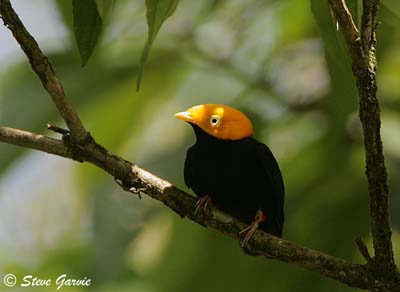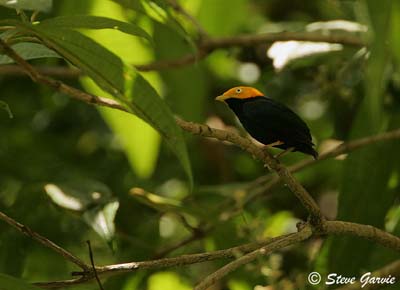
Golden-headed Manakin
Pipra (Dixiphia) erythrocephala
Passeriforme Order - Pipridae Family
BIOMETRICS:
Length: 8-9 cm; Weight: 12-14 g
DESCRIPTION:
Golden-headed Manakin is a compact and brightly coloured bird. It lives in forests, in tropical regions of South America.

Adult male has black body plumage, with red and white thighs.
Head is orange-yellow on forehead, crown, cheeks and upper nape. This golden yellow helmet is slightly bordered with red, very indistinct and difficult to see.
The thin bill is yellowish-white. Eyes are white. Legs and feet are pinkish-brown.
Female is very different with olive-green plumage overall. Underparts are paler, mainly on washed yellowish belly. She has rather grey eyes than white.
Juvenile is similar to female with grey eyes too. Immature male has some adult feathers after the first moult, and it acquires complete adult plumage after the second moult, at the beginning of its second year.
We find two subspecies:
P.e.erythrocephala and P.e. berlepschi. The last one has yellower crown with narrow but sharper red edge.
VOICE: SOUNDS BY XENO-CANTO
Golden-headed Manakin is very noisy during displays. It utters sharp chipping and trilling notes. We can also hear an accelerating series of “kew” ending in sharp buzz.
Male’s advertising call is a clear “pu”. When it is very excited, it gives a trill ending in sharp notes “pu-prrrrrr-pt” or “pir-pir-prrrrrrrr-pt-pt”. It also utters short “zit-zit”.
HABITAT:
Golden-headed Manakin frequents humid forests, mainly open second growth woodlands. It is visible up to 1100 metres of elevation, but locally, it may be seen up to 2000 metres.
RANGE:
Golden-headed Manakin is resident in its range from Panama, Colombia and Trinidad, to the Guianas, Brazil and northern Peru.
BEHAVIOUR:
Golden-headed Manakin feeds mainly on small fruits, and particularly the berries of Miconia, Melastomataceae family, and also Rubiaceae. The fruits are plucked in flight. It also catches insects snatched in flight and from vegetation, and spiders.
Golden-headed Manakin, as other manakins’ species, performs complex courtship displays at communal lek. The male spends most of the time perched in the lek, often inactive, just uttering brief calls. It keeps this area clean, that means it removes leaves and some vegetation which may make obstruction in this place.
The lek behaviour of the Golden-headed Manakin involves several males displaying together. They display on relatively horizontal branches, but higher than other manakins’ species, at about 6 to 12 metres above the ground. Each male has its own main mating perch, about 2 to 3 metres apart in a tree or even up to 10 metres apart in close tree.

Number of males may vary and usually depends on populations. When they are numerous in a range, we can see up to 12 males displaying. Active display can be stimulated if a female arrives at the lek.
Golden-Headed Manakin displays include five phases.
The first phase includes rapid flights to and fro between the main perch and an adjacent close perch, with wings producing some noises during the short flights. It turns in the air before landing, facing the way from which it came.
In the second phase, the bird remains at the same place and performs rapid “about-face” accompanied by flick of the wings.
During the third phase, the bird is always at the same place with stretched legs, head low and raised tail. It moves with short and rapid steps backwards along its perch for 10 to 20 cm. At the end, it depresses and fans its tail while it raises the wings vertically above its back.
The fourth phase is a particular posture with head and body stiff in upright attitude and during several seconds. The bird clings to the perch side with contracted pupils and slightly open bill.
The fifth phase is a flight display. The male leaves its perch and flies higher, at about 15 to 25 metres away on another perch, facing its main perch. It utters some sharp notes, takes off and returns to its main perch in very rapid flight, and always uttering series of the same note. When approaching the main perch, it performs a brief downwards swoop and an upwards swoop, and when it is alighting, it utters a buzzing call.
These displays are often performed even if female is absent. But when a female arrives at lek, the displays increase and are continuous. She may perform some display, but less actively. When she is receptive and ready for mating, she goes to the mating perch of one of the males. Copulation usually occurs after the flight-displays where the male lands close to the female and mounts. (HBW-Volume 9)
FLIGHT:
Golden-headed Manakin has rapid and agile flight during the courtship displays.
REPRODUCTION:
Breeding season varies according to the range.
The Golden-headed Manakin male does not take part in nesting duties.
The nest is placed in a fork between horizontal twigs of young tree or shrub, in low branches, at about 1, 5 to 10 metres above the ground. The small cup is made with woven fibres, dead leaves and rootlets, and the interior is lined with few dead leaves. The cup it attached with spider webs.

Female lays two eggs. She incubates during 16 to 17 days. There is no information available about the fledging period.
DIET:
Golden-headed Manakin feeds mainly on small fruits plucked in flight. It also takes insects and spiders caught in flight from vegetation.
PROTECTION / THREATS / STATUS:
Golden-headed Manakin is fairly common to common in most parts of the range. This species is not threatened at this moment.
Fr: Manakin à tête d’or
All : Gelbkopfpipra
Esp : Saltarín Cabecidorado
Ital : Manachino testadorata
Nd : Goudkopmanakin
Russe : Желтоголовый настоящий манакин
Photographs by Steve Garvie
His website: RAINBIRDER Photo galleries
Text by Nicole Bouglouan
Sources :
HANDBOOK OF THE BIRDS OF THE WORLD Vol 9 - by Josep del Hoyo - Andrew Elliot - David Christie - Lynx Edicions - ISBN: 8487334695
A GUIDE TO THE BIRDS OF COLOMBIA by Steven L. Hilty and William L. Brown - Princeton University Press – ISBN 069108372X
Arthur Grosset's Birds (Arthur Grosset)
Birds in Suriname, South America (Jan Hein Ribot)
Wikipedia (Wikipedia, The Free Encyclopedia)